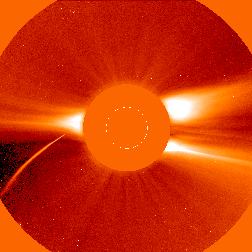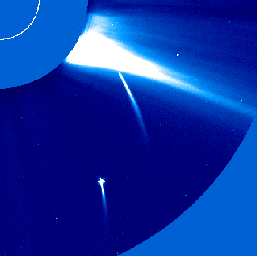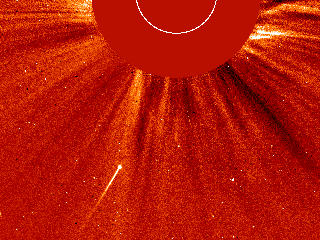SOHO Comet 100

|
| Click on the image for a full-size version |
| Movies: MPEG, QuickTime, Animated GIF. |
Explanatory note: In this and all subsequent coronagraph images, the shaded disk is a mask in the instrument that blots out direct sunlight. The white circle added within the disk shows the size and position of the visible Sun.
Caption:
Calculations confirm that a comet spotted by Kazimieris Cernis of
Vilnius, Lithuania, on 4 February is a previously unknown object,
making it the 100th comet discovered with the SOHO
spacecraft. Launched four years ago as a project of international
cooperation between the European Space Agency and NASA, the Solar and
Heliospheric Observatory has revolutionized the science of the Sun. It
has also revealed an amazing number of kamikaze comets plunging into
the solar atmosphere, which help to make SOHO the most prolific comet
finder in the history of astronomy. But SOHO-100 is an ordinary comet,
and so are two others that have appeared in the past few days.
More information available in the ESA Press Release
Instrument: LASCO (Large Angle and Spectrometric Coronagraph) Taken: 4 February 2000
Sungrazing Comets Discovered by SOHO
The 1996 Christmas Comet (SOHO-6)

|
Caption:LASCO C2 image of the solar corona on 23 December 1996
at 04:44 UT showing the inner streamer belt along the Sun's equator,
where the low latitude solar wind originates and is accelerated. Over
the polar regions, one sees the polar plumes all the way out to the
edge of the field of view. The field of view of this coronagraph
encompasses 8.4 million kilometers (5.25 million miles) of the inner
heliosphere. The frame features Comet SOHO-6 with its tail curving
towards the lower left side of the image.
Full Resolution image. Movies:MPEG, QuickTime |
Twin Comets (SOHO-54 & 55)

|
In a rare celestial spectacle, two comets were observed plunging into
the Sun's atmosphere in close succession, on June 1 and 2, 1998. This
unusual event on Earth's own star was followed on June 2 by a likely
unrelated but also dramatic ejection of solar gas and magnetic fields
on the southwest (or lower right) limb of the Sun.
Full C2 field of view Movies: MPEG: C2, C3, QuickTime: C2, C3. |
SOHO Comet 48

|
This Kreutz sungrazing comet from April 30, 1998 was observed
in the LASCO C2 telescope. The comet is seen to fade rapidly as it
approaches the Sun over a period of just 5 hours. The comet's nucleus
is overexposed in the first few frames, resulting in the visible
diffraction spikes.
Movies: MPEG, QuickTime, Animated GIF. |
Other Comets Observed* with SOHO
*Not necessarily discovered by SOHO.
For an exhaustive list of all comets discovered by SOHO, go to
the Sungrazer site.
Comet Hyakutake

|
Discovered by Yuji Hyakutake in Japan on 30 January 1996, this
conspicuous comet passed grandly through LASCO C3's field of view at the
beginning of May 1996. Even bright comets are not normally visible so
close to the Sun in the sky, without the benefit of the artificial
eclipse in a coronagraph such as LASCO.
Movies: MPEG: small, full size, QuickTime. |
SOHO Comet 49

|
 Copyright (c) 1998 Michael Horn |
|
Movies: MPEG,
Animated GIF. This sequence shows C/1998 J1 as it skirts the edge of the LASCO C2 field of view. This comet, the 49th discovered by SOHO, is not a Kreutz sungrazer. Shortly after SOHO-49 was discovered, it was realized that it could eventually be observed from the ground. Also visible are several explosions of material, 'mass ejections' from the solar corona. | A ground-based image of SOHO-49, courtesy of Michael Horn of Brisbane, Australia. He kindly agrees to the use of this image by the media and other third parties in connection with the ESA and NASA news releases about SOHO-100. For any other usage, permission from Michael Horn will be required first. Click on the image for a larger version. For more ground-based images of this comet, go to this site |
A Flyby (SOHO-46)

|
This dramatic movie shows comet C/1998 G3 (SOHO-46). This
comet, while not a Kreutz sungrazer, approaches to within 7 solar radii
(4.5 million kilometers) of the Sun. The comet is seen to `whip'
around the Sun and then fade from view. This comet fades not because
it has burned up, but because it is receding from the Sun. Note, at
the beginning of the sequence, a faint Kreutz sungrazer (SOHO-47) can
be seen, quickly moving towards the Sun from the bottom of the picture.
It takes sharp eyes to find the Kreutz comet, as there is no visible tail.
Movie: MPEG, QuickTime. |
Comet Hale-Bopp Observed by the SWAN Instrument

|
A huge cloud of hydrogen surrounded Comet Hale-Bopp when it neared the
Sun in the spring of 1997. Ultraviolet light, charted by the SWAN
instrument on the SOHO spacecraft, revealed a cloud 100 million
kilometres wide and diminishing in intensity outwards (contour
lines). It far exceeded the great comet's visible tail (inset
photograph). Although generated by a comet nucleus perhaps 40
kilometres in diameter, the hydrogen cloud was 70 times wider than the
Sun itself (yellow circle to scale) and ten times wider than the
hydrogen cloud of Comet Hyakutake observed by SWAN on SOHO in 1996.
Solar rays broke up water vapour released from the comet by the warmth
of the Sun. The resulting hydrogen atoms shone by ultraviolet light
invisible from the Earth's surface. Even a satellite's view of the
Hale- Bopp cloud would be spoiled by hydrogen around the
Earth. Stationed 1.5 million kilometres out in space, SOHO had a clear
view. SWAN is the brainchild of Jean-Loup Bertaux and colleagues at
the Service d'A[e/]ronomie du CNRS (France) and the Finnish
Meteorological Institute. Tuned to see hydrogen, SWAN scans the sky
and studies the solar wind's effect on hydrogen atoms coming from
interstellar space. Comets reveal themselves as local sources of
hydrogen. With SWAN's maps, Michael Combi of the University of
Michigan studies gas outflow from comets. He also uses the Hubble
Space Telescope, but that instrument cannot safely look at comets near
the Sun. The unique SWAN observations of Comet Hale-Bopp imply that
the outflow of water vapour peaked at almost 50 million tonnes a day.
Credits: Main image: SOHO (ESA & NASA) and SWAN Consortium Inset photo
of comet: Dennis di Cicco and Sky & Telescope
Movie: MPEG |


